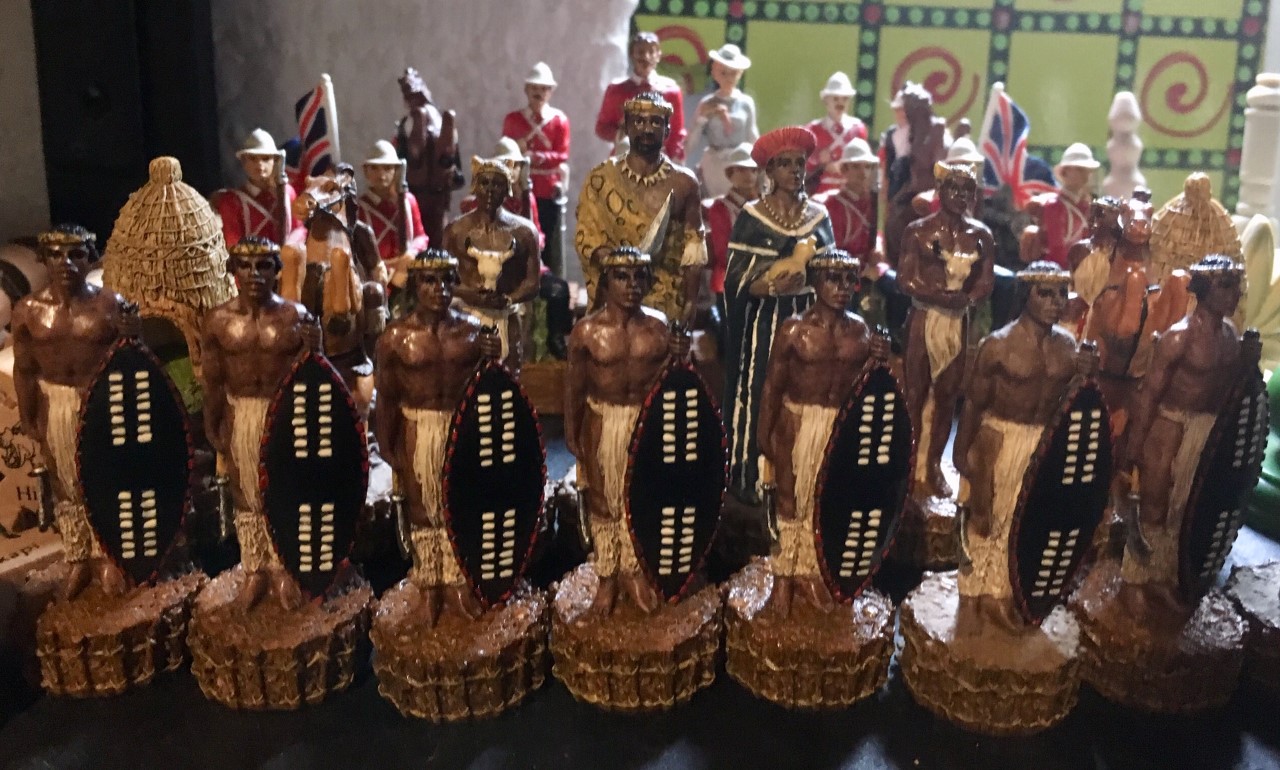In the nineteenth century, the British occupied half the world. The Cape had already been colonised and in the 1870s they became interested in the Zulu kingdom in the eastern part of South Africa. The brave Zulu warriors, however, did not give up their territory without a fight. In 1879, this led to the bloodiest battles in British military history until then.
The Zulu-British chess set is part of the Rademaker Collection which is on display at the Chessmen Museum. The military equipment of both parties show that the battle 140 years ago was a lot more unfair than it is on the chessboard. With their spears and shields, the Zulu warriors faced the British soldiers who were equipped with guns and cannons. Although the British outweighed the Zulus weapon-wise, the Zulu people made life more than complicated for the British. The Zulus did have everything to lose.
The British had annexed the neighbouring Transvaal region in 1877 because of the gold and diamond mines in the area. They were not the only European country that was colonising, and they did not want to lose the resources of Transvaal. But with this annexation they inherited the lingering border conflicts between the white farmers from Transvaal and the Zulus. Previously, the British had supported the Zulu people, but now they gave them an ultimatum. Zulu king Cetshwayo kaMpande was given until the end of 1878 to dismantle his army and surrender the men who had entered the new British territory.
Zulu attack
KaMpande refused and after the ultimatum had come and gone, the British invaded the Zulu territory on January 11, 1879. After a week of marching, the British set up camp at Isandlwana. A large part of the army then moved on and 1,700 British soldiers, including African allies, stayed behind to guard the camp. The English did not realise that the 23,000-strong Zulu army was close to Isandlwana. On the night of January 22 to January 23, the camp was attacked by 4,000 Zulus…
With the help of their guns, the British lasted a long time and repeatedly repelled the attacks. But the superiority of the Zulus was too great. The rest of the British army did not realise until sunrise that the Zulus had attacked their army camp with full force. They hurried back, but it was too late. A total of 1,329 Britons and their African allies were massacred in a battle that would be called the most disgraceful battle in British military history. There were also many casualties among the Zulu army: an estimated 3,000 men. A Zulu warrior commented: “The grass was red with blood and the battlefield was slippery because of the brains and intestines of the dead.”
British better prepared
After this battle, the British no longer let themselves be surprised. It was precisely the surprise element and the superior force of men that had given the Zulus enough advantage to eventually get through the gun bursts at Isandlwana. In the confrontations that followed, the attacking Zulu warriors were gunned down before they could reach the British with their spears. On the misty morning of April 2, for example, 12,000 Zulus attacked the 1,700 entrenched British soldiers at Eshowe. Within 90 minutes the battle was over and the British cavalry completed their work by going after the fleeing Zulus. The 13 deaths on the British side were nothing compared to the many deaths among the Zulu people.
The decisive major battle took place on July 4 at Ulundi, where King KaMpande’s estate was. Negotiations with the king were unsuccessful and the British troops, supplemented with new soldiers, formed a square of over 5,300 soldiers, hoping to provoke the Zulu people. It worked and around 15,000 Zulu warriors, invisible in the tall grass, surrounded the square. But as they attacked, they were unable to get through the shower of bullets, just as the British had hoped. This massacre lasted only half an hour and again the cavalry went after the fleeing Zulus, “skewering them on their long lances as though they were pigs”.
Divided kingdom
King Cetshwayo managed to escape, and hid from the British troops that were hunting him. Only with the capture of their king would the Zulus be defeated. The British even offered a reward for the person who would reveal the king´s location, but the loyal Zulu subjects did not betray their leader. They kept silent and set out false traces to mislead the British, thus saving their king from the enemy. A distracted Zulu boy trusted the wrong person, and the British discovered Cetshwayo’s whereabouts at the end of August. The imprisoned king was taken away and shipped to London.
The British then made sure that the Zulu kingdom no longer had any real power. They divided it into 13 small kingdoms with British-minded kings who had to answer to a British representative. This new system did not take into account the Zulu customs and previous border agreements though. The Zulu people were dissatisfied and fights soon broke out both within and between the kingdoms. In 1881, the British established that their system had failed, and in the meantime they also had their hands full with the rebelling Boers in Transvaal.
Cetshwayo was the solution. Queen Victoria liked him, and she gave the old king his throne back, be it under certain conditions. Once back in Africa, Cetshwayo had a lot less influence than he thought he would. The British had greatly reduced his power, his empire had shrunk in size and the tribal chiefs questioned the authority of their king. His own cousin in particular tried to seize power. The king eventually died in 1884, possibly of poisoning. The British wanted stability and ended up annexing the entire Zulu country in 1887. This put a definite end to the Zulu kingdom that had been founded by the famous warrior king Shaka Zulu in 1816.





You must be logged in to post a comment.